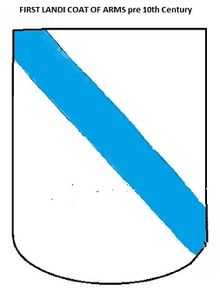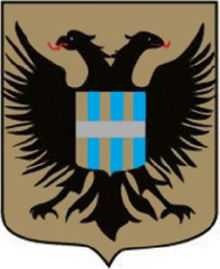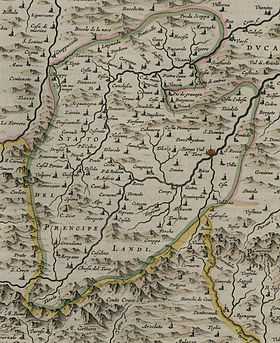House of Landi
The House of Landi is an Italian family, with links to royalty.


The House of Landi
The name Landi originated in the third century with Panfirio Landus,[1] a Roman Senator. The family produced two Bishops one, the bishop of Cosilinum (or Marcellianum), present at the Roman synod of 743, and, Antonio Luigi Landi, O.F.M., Bishop of Lu’an (1804-1814).[2] One Cardinal Francesco Landi (cardinale)[3][4]) also one Pope: Pope Lando Father: Tiano Landus, family name "Landus" Paternal name "Landus".[5] [5] [6][7][8][9] It was common in Vatican documentation to use the last name of Landi, Landus and Lando interchangeably, at times, in the same documents. [5]
[10] Most Landi's during the second millennium are referred to as: "de Landi" (The Landi) of The Landi State, The House of Landi being its origin. During the Dark Ages mostly wealthy families and royalty used surnames, making their historical origins bit clearer. Some examples of the Landi (or Lando/Landus) being Lando I of Capua, Lando II of Capua Lando III and Lando IV of Capua are all rooted in the Lando/Landus/Landi family names.[5][11][12] The House of Landi became the ruling family of The Landi State [Lo Stato Landi].[13]
The Landi State

The Landi State in Italy was founded by Rodolfo Landi in 1188.[10] It later became a state of The Holy Roman Empire. The first prince of the House of Landi was Count Manfredo III Landi,[15][10] who bore the title Prince of the Holy Roman Empire.[16][17] The Landi State dominated the Province of Parma from the 13th through the 16th century. At its peak, The Landi State[18] extended 1,776 square kilometres (686 sq mi), the largest in Italy at that time,[10][19] and to this day the longest lived state in the history of Italy(425 years).[20] Their power was such that they were the only state within the Holy Roman Empire allowed to mint their own coinage. [10][Note 1][21] The Landi were known to be warlords and renowned commanders of their own mercenary armies, maintained in the over 102 castles. The Landi State owned more than 100 castles, cities and towns in the north of Italy alone.[6][22] These cities and towns do not include land holdings given to The Landi by the King of Naples, and title of Duke of(Venafro) Some of the northern cities and towns of Sicily were also owned by The Landi, Del Cereto.[6][19]
The Royal Landi
The Royal Landi line starts with Rodolfo Landi in the 12th century, and includes notable members Prince Obizzo Landi,[23] a Prince of Piacenza (1328). After a broken friendship with Galeazzo Visconti, he joined the Guelph party and moved to Piacenza and ruled on behalf of the Church. The family also includes Prince Ubertino Landi also in the 14th century.[24] Then Count Manfredo III. known as “El Magnifico” of 15th century, along with his three sons, Frederico,[25] Pompeo(Castello Rivalta)[6] and Corrado, and numerous other Landi Princes.[6][26] The lineage of the House of Landi was unbroken from the 12th to 17th century.[10] The Landi produced a Duke of Naples, a Duke in Venice, and Marquesses in Parma and Piacenza, also Marquis of Ivaccari, and were Princes of Melfi; Marquises of Chiavenna (with dominion over 35 cities and towns), Counts of Compiano (with dominion over 73 cities and towns), and Barons of Bedonia (with dominion over 89 cities and towns).[10]
The Royal bloodline of the Landi family extends through many of the other houses of Europe through intermarriage.[27] They include:
- The German Hapsburg[28][28][29][30] and Hohenstaufen families
- The family of King Philip III of Spain
Landi Royalty "House of Landi" in Parma continues to the 21st century, through the 18th century merger of the Doria-Pamphili-Landi families
Landi Royalty also survives through Countess Franca Zanardi Landi di Veano and others listed elsewhere[13][32]
The Landi and The Holy Roman Empire
The Landi were known to be friends and advisors to the Holy Roman Emperors for centuries, and masters of their mountaintop castle/fortress at Bardi; the largest in all of Europe – from which they ruled their Principality"[22] Landi family members have interacted with many of the Popes (among them; Pope Urban VIII,[33][34] Sixtus V,[35] including Antonio Zanardi Landi, the current Ambassador of the Vatican to Italy.[36] also: Bartolomeo Grassi-Landi, a non-cardinal and the conclavist (Papal Conclave)of Cardinal Luigi Oreglia di Santo Stefano 2014. The Landi Princes ruled over a 700 year period. Roldopho Landi's Nobility of Italy G.Great Grandson (Ubertino Landi I) married ("Sabella of Argon")[37] of the medieval Kingdom of Argon Spain thus the first connection of the The Landi State to the Spanish. "In 1257 Count Ubertino Landi[6][24][38] bought outright the entire city of Piacenza[39] and the high territories of the Vally’s of Ceno and Taro, origin of the Taro (river) with the great benefit of now owning the Castle of Bardi, Emilia-Romagna which he fortified, rebuilt and expanded, then the largest castle in Europe".[40] The Landi[12] remained the Lords of Bardi, Emilia-Romagna for the next four centuries. Known as one the most defensible Castle’s anywhere in the world. It gave The Landi State geographical control of the river and its tributary Ceno Noveglia along with all the surrounding territories. Lands from Sicily were forfeited to Ubertino Landi for the return of, The King of Sicily,"Manfredi", “Ubertino during the fight at Benevento 1298 held The King of Sicily "Manfredi" and his two sons as prisoners”,[41] expanding the sphere of The Landi's influence far from The Landi State.
Landi Princes of Val di Taro
As rulers of The Landi State[42] centering on Count Manfredo III Landi (1429 to 1488) who insisted on being call “El Magnifico,” during his reign, was to see change after his death when Manfredo's sons, Frederico,[25] Pompeo(Castello Rivalta)[6] and Corrado[6] split up the kingdom their father ruled through 1488.[6] This created three new branches of the Landi family. Compiano/Rivalta Bormida/Bardi. Through land grants Manfredo had greatly expanded the power, influence and size of The Landi State Gaining territory throughout Liguria, Lombardy, Tuscany, Emilia-Romagna and as far south as Venafro The Kingdom of Naples also from the northern areas of Sicily. Other expansion would happen in the future under Don Fredrico who also maintained,The archive Landi, which was moved to Genoa in 1682. It was known to include many thousands of books, many Incunable's, among them 3000 Latin scrolls, many which dated back as far as the ninth century. Including some "Used as a university with which the Emperor Louis II renews concessions and confirms the properties to the monastery of St. Columbanus (February 2, 863).[43]”. Much later in the 19th century; Marquess Ferdinand Landi (1850) bequeathed his extensive Library growing to over 43,000 volumes to The Landi Library to continue in the Landi Mansion, eventually this would also be added to the “Library Passerini-Landi” originally created in 1791 from the merger of the "Royal Landi Library", established by Ferdinand Landi of Bourbon with books donated by the Jesuits, with the "Library Passerini," creating Biblioteca passerini Landi Library. As pertaining to the Board of Theologians. During the Kingdom of Italy Napoleonic government, a government decree of 1811 declared the library "Comunitativa" entrusting the administration to the Municipality of Piacenza. Biblioteca Passerini Landi Library survives to this day [44](2014).[45]
The Landi/Farnese conspiracy
The Landi who were bitter enemies, and known to be the assassins of the House of Farnese,[46][47] In 1547 Count Agostino Landi was among the planners of a conspiracy that led to the killing of Pier Luigi Farnese, Duke of Parma and Piacenza. The Death of Pier Luigi Farnese, by Count Agustino Landi among others was a "wide ranging conspiracy". Farnese’s firm rule and his taxes gained him the enmities of the cities, which were used to the fair authority of the Popes, and he was also no friend of the Aristocracy either, including Emperor Charles V who gave the go ahead for the plot to kill Pier Luigi Farnese, Duke of Parma .Emperor Charles V, aimed to unite Parma and Piacenza to the Duchy of Milan. It was Ferrante Gonzaga the governor of Milan who, hearing that Charles V wanted to take possession of the cities, actually launched the plot. Ferrante Gonzaga began to spy on Pier Luigi and sent reports continually to Madrid. Charles V, concerned about the progress in Parma, gave free rein to Ferrante Gonzaga to organize a conspiracy against the duke. Marquis Pallavicini Cortemaggiore offered support; but Ferrant preferred to rely on his distant kinsman Louis Gonzaga, Lord of Castiglione, his brother Count Giovanni Anguissola, governor of Como. Anguissola convinced Count Agostino Landi, Marquis Giovan, Luigi Confalonieri, and Girolamo Alessandro Pallavicini to join him. After Anguissola and the 6 others had stabbed Pier Luigi Fannese to death, in a scene reminiscent of Caesar's assassination at the hands of the Senate 1500 years earlier, the conspirators then hung his body from a window of his palace in Piacenza. It was Charles V's vicar Ferrante Gonzaga who captured the Duchy soon after. "The ongoing vendetta between The Landi and Farnese would continue for generations after the assassination of Pier Luigi Farnese, the First Duke of Parma and Piacenza. This would eventually lead to King Philip lll awarding of “The Golden Fleece” to Prince Frederico Landi in the year 1612, this would effectively make him untouchable, after his return as "Regent of Monaco" to Val di taro, lo Stato Landi.[48]
Monaco
The House of Landi is significant in the history of Monaco and the House of Grimaldi. Maria Landi (1582 - 19 January 1599) became Lady Consort of Monaco by her marriage to Prince Hercules I of Monaco. Maria Landi died during the birth of their third child. In November 1604, following the assassination of Hercules I, the children, including Honoré II, were rescued from the palace by the house servants, and were brought up in the care of Prince Frederico Landi of Val di Taro.[49] Frederico returned to Monaco to rule as regent for Honoré II.
At this time, Monaco had been a protectorate of Spain, based on the oath of allegiance sworn by Honoré I, Lord of Monaco. When Honoré II returned to rule in his own name, he requested two things from King Philip III: first that Monaco be recognized as a principality; and second that Honoré II be recognized as its first prince. This recognition was granted in 1633, but it wasn't until the Treaty of Péronne (1641) that Monaco was finally free of Spanish influence and came under the protection of France instead. Unfortunately Honoré II lost all his Italian and Spanish possessions in the process, but in the end King Louis XIII of France awarded him with the Marquis of Baux and the title of Duke of Valentinois.[50][51]
Lineage
The Landi (de Landi) family lineage is captured in full from its beginnings in documents held in the Vatican Archives. Members of the family have been prominent among the major chivalric orders of Europe:
- Order of the Golden Fleece[51]
- Knights Hospitaller
- Order of Saint Stephen
- Order of Saint Michael of the Wing
- Order of the Crown of Italy
- Grandees of Spain
Notes
- ↑ These coins still occasionally turn up at auction, capturing bids as high as $65,000.
References
- ↑ "SEARCH EXCEPTION". Archiviodistatoperugia.it. Retrieved 12 December 2014.
- ↑ "Diocese of Changzhi [Luan]". Catholic-Hierarchy.org. David M. Cheney. Retrieved 21 January 2015.
- ↑ "Vatican Library - Manuscripts Catalogue". Vatlib.it. Retrieved 12 December 2014.
- ↑ "Francesco Cardinal Landi Pietra". Catholic-Hierarchy.org. David M. Cheney. Retrieved 21 January 2015.
- ↑ 5.0 5.1 5.2 5.3 By Pierre Bayle, Pierre Des Maizeaux, Alexis Gaudin, Anthelme Tricaud, By Pierre Bayle, Pierre Des Maizeaux, Alexis Gaudin, Anthelme Tricaud, ed. (1736). "3, 11, 13,16,". The dictionary historical and critical of Mr. Peter Bayle 3. J.J. P. Knapton Publisher. p. 982.
- ↑ 6.0 6.1 6.2 6.3 6.4 6.5 6.6 6.7 6.8 "Castello di Rivalta". Castello di Revalta. Retrieved 12 December 2014.
- ↑ Catholic Online. "Pope Lando". Catholic.org. Retrieved 12 December 2014.
- ↑ "Pope Lando". Cruxnow.com. Retrieved 12 December 2014.
- ↑ "Patron Saints Index: Pope Lando". Saints.sqpn.com. Retrieved 12 December 2014.
- ↑ 10.0 10.1 10.2 10.3 10.4 10.5 10.6 John Morello, John Morello, ed. (1983). "Monaco". lo Stato Landi by, Cardinale Antonio Samore 1. John Morello Publisher. p. 120. ISBN 9788885042100.
- ↑ "Pope Lando". Academic Dictionaries and Encyclopedias. Retrieved 12 December 2014.
- ↑ 12.0 12.1 "The LANDI, Italy". Enciclopedia (in Italian). Treccani. Retrieved 3 December 2014.
- ↑ 13.0 13.1 Samorè, Antonio Cardinal (1983). Lo Stato Landi. Collectanea Archiva Vaticani.
- ↑ "Bardi Castle". Castles of Parma. Retrieved 17 November 2014.
- ↑ name="doriapamphilj.it">"The Doria Pamphilj Archive". Doriapampilj.it. Retrieved 13 December 2014.
- ↑ John Morello, John Morello, ed. (1983). "Monaco". lo Stato Landi by, Cardinale Antonio Samore 1. John Morello Publisher. p. 120. ISBN 9788885042100. >
- ↑ "The Cardinals of the Holy Roman Church - Biographical Dictionary - Consistory of September 9, 1743". Fiu.edu. Retrieved 12 December 2014.
- ↑
- ↑ 19.0 19.1 "Bardi Castle". Castles of Parma. Retrieved 17 November 2014.
- ↑ <http://www.castles.org/castles/Europe/Western_Europe/Italy/Bardi.htm
- ↑ Michael, Thomas (2009-11-18). Standard Catalog of World Gold Coins Hardcover 6th edition. (6th ed.). Standard Catalog of World Gold Coins. p. 112. ISBN 1440204241.
- ↑ 22.0 22.1 "Welcome to Casa Landi". Casalandi.net. Retrieved 12 December 2014.
- ↑ http://www.treccani.it/enciclopedia/obizzo-landi/
- ↑ 24.0 24.1 "LANDI, Ubertino". Enciclopedia (in Italian). Treccani. Retrieved 17 November 2014.
- ↑ 25.0 25.1 "LANDI, Fredrico". Enciclopedia (in Italian). Treccani. Retrieved 3 December 2014.
- ↑ https://it.wikipedia.org/wiki/Onorato_II_di_Monaco
- ↑ "Vatican Library - Manuscripts Catalogue". Mss.vatlib.it. Retrieved 12 December 2014.
- ↑ 28.0 28.1 "A Remarkable Book". Trove.nla.gov.au. Retrieved 12 December 2014.
- ↑ "Full text of "My years at the Austrian court"". Archive.org. Retrieved 12 December 2014.
- ↑ "Women of History - Z". Abitofhistory.net. Retrieved 12 December 2014.
- ↑ "Isabella of Aragon". Kleio.org. Retrieved 12 December 2014.
- ↑ "02 - October - 2012 - NettyRoyal". Nettyroyal.wordpress.com. Retrieved 12 December 2014.
- ↑ "The Galileo Project - Galileo - Patrons - Pope Urban VIII". Galileo.rice.edu. Retrieved 12 December 2014.
- ↑ "Vatican Library - Manuscripts Catalogue". Mss.vatlib.it. Retrieved 12 December 2014.
- ↑ "Legendary Rome - Sixtus V, the tough pope". Andreapollett.com. Retrieved 12 December 2014.
- ↑ "Address to the new Ambassador of Italy to the Holy See". Vatican.va. Retrieved 12 December 2014.
- ↑ "LA FORTEZZA DI BARDI". Valcenoweb.it. Retrieved 13 December 2014.
- ↑ Landi delle Caselle (ramo di Pompeo)(Landi della Castelle
- ↑ "Piacenza in "Enciclopedia Italiana" – Treccani". Treccani, l'Enciclopedia italiana. Retrieved 13 December 2014.
- ↑ "LA FORTEZZA DI BARDI". Valcenoweb.it. Retrieved 13 December 2014.
- ↑ "LusardiFamily.com". Lusardifamily.com. Retrieved 12 December 2014.
- ↑ "The Doria Pamphilj Archive". Doriapampilj.it. Retrieved 13 December 2014.
- ↑ "Gallerio : Archive". Doriapampilj.it. Retrieved 12 December 2014.
- ↑ "Biblioteca Passerini Landi". Foursquare. Retrieved 12 December 2014.
- ↑ "Sede Centrale". Passerinilandi.biblioteche.piacenza.it. Retrieved 12 December 2014.
- ↑ "Landi in "Enciclopedia Italiana" – Treccani". Treccani, l'Enciclopedia italiana. Retrieved 12 December 2014.
- ↑ Olschki, Leo S., ed. (1863). "Barbara Sanvitale e la congiura del 1611 contro i Farnesi; Cenni storici, di Federico Odorici, con documenti". Archivio storico italiano. Deputazione toscana di storia patria. pp. 100–106.
- ↑ Hanlon, Gregory., ed. (2014). "Farnese". "The hero of Italy : Odoardo Farnese, Duke of Parma, his soldiers and his subjects in the Thirty Years' War" APA (6th ed.) 1. Hanlon, G. Publisher. p. 120. ISBN 9788885042100. >
- ↑ Landi delle Caselle (ramo di Pompeo)
- ↑ Ring, Trudy; Salkin, Robert M.; La Boda, Sharon, eds. (1995). "Monaco". International Dictionary of Historic Places 3. Taylor & Francis. p. 451. ISBN 9781884964022.
- ↑ 51.0 51.1 Royal Family of Monaco at Burke's Peerage
External links
- "Bardi Castle". Castles of Parma. Retrieved 17 November 2014.
- "LANDI, Claudio". Dizionario Biografico (in Itlaian). Treccani. Retrieved 17 November 2014.
- "LANDI, Ubertino". Enciclopedia (in Italian). Treccani. Retrieved 17 November 2014.
- "LANDI, Fredrico". Enciclopedia (in Italian). Treccani. Retrieved 3 December 2014.
- "LANDI, Manfrado III". Enciclopedia (in Italian). Treccani. Retrieved 3 December 2014.
- "The LANDI, Italy". Enciclopedia (in Italian). Treccani. Retrieved 3 December 2014.
- Antonio Samorè (1983) Collectanea Archiva Vaticani, "Lo Stato Landi", 16 Cardinal Antonio Samore d1983
Title: Documents the Vatican Secret Archives and the Vatican Apostolic Library of the State-Landi A genealogy of the seventeenth century Landi ... Authors: Antonio Samore, John Morello Publisher: Vatican Secret Archives (The Secret Vatican Library) Necklace: Collectanea Vatican Archives Date Publication: 1983 ISBN 9788885042100 Pages: 120 Department: Religion> Christianity> Churches and Christian denominations> History of the church. Every one of these books and documents from the Vatican Archives, Titles and specific reference numbers are listed in the book: "Lo Stato Landi,", by Antonio Samore' (1983). Referenced from: 97 books, documents and manuscripts from the "Vatican Secret Archives". 6 from Biblioteca Apostolica Vaticana (BAV), 19 from Archivo Doria Landi Pamphilj (ADLP) (Released by the Cardinal for publication on his deathbed) He stated: "the history of his homeland should be complete".